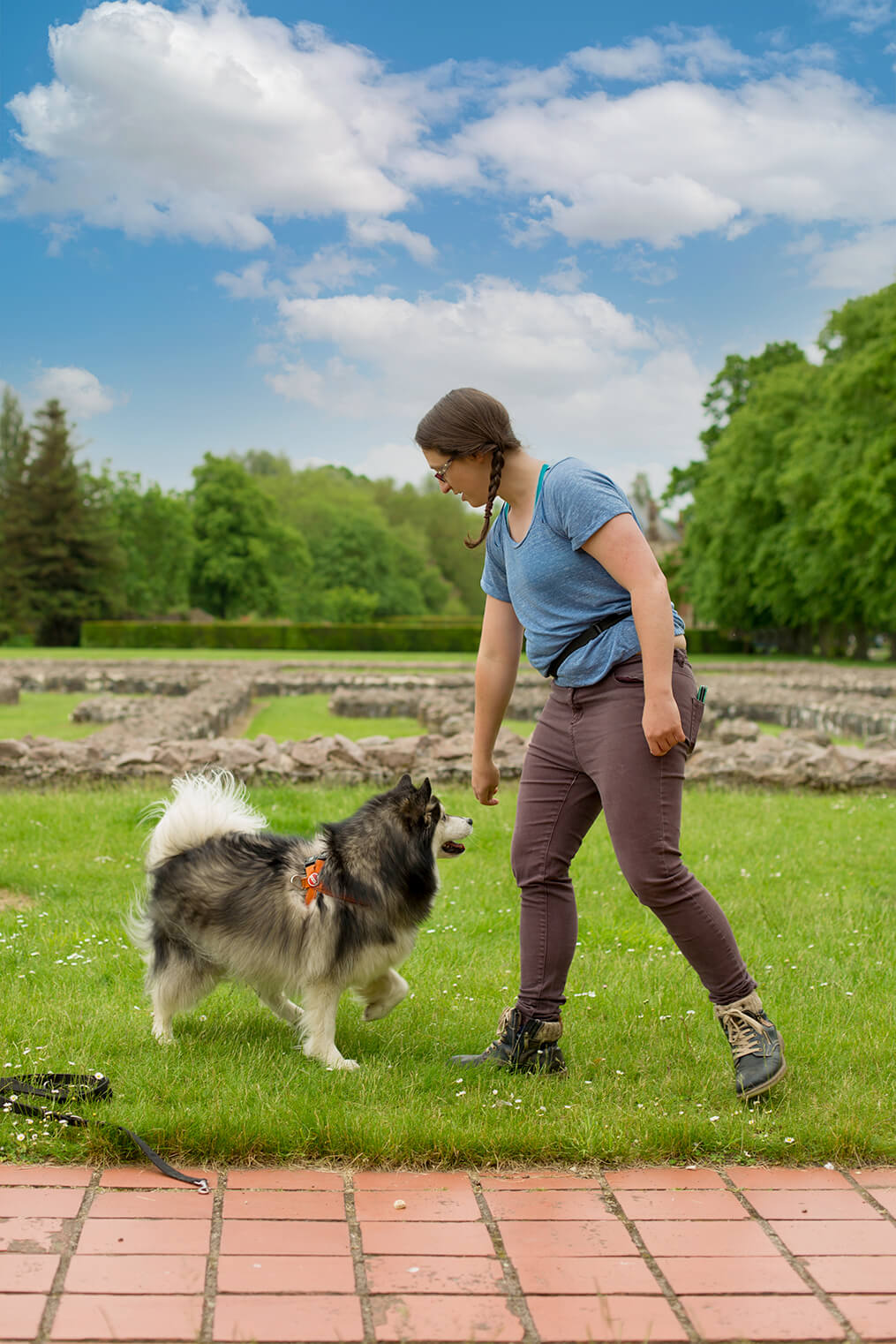Frequently Asked Questions.
Dog Behaviourist, Michelle Merrill, answers all your burning questions around Dog & Puppy Training in our most Frequently Asked Questions.
You may have been to a dog trainer who used fear, force or pain to train and found it hasn’t worked for you and your dog. (The reason being is that fear, force and pain, apart from being an awful way to treat a dog, isn’t the smartest way to do it) Or you may have seen a trainer who didn’t understand you or your dog’s specific needs. Your previous trainer may have been great at training their own dogs, using positive reinforcement and breed understanding but may not have been good at teaching humans how to train dogs. You may have gone to a great dog trainer, Crufts level obedience, but what you actually need is a behaviourist as you’re having behavioural issues (luckily I am a behaviourist!) Or maybe you and the previous trainer/behaviourist just didn’t get along. There are many reasons why working with a trainer or behaviourist didn’t work for you.
This is why I take the time in the initial consultation to get to know you and your dog. In all sessions, I explain in relatable terms why your dog is behaving the way it is and then give you practical training and solutions to start to change things. After the session, you will be provided with notes and how to’s on the things we’ve just worked on so you can refer to them afterwards. Depending on which package you choose, I can provide you with video training guides and ebooks.
I want you and your dog to succeed whilst working with me, so I do all I can to set you up for success. But most importantly – if you are willing to put in the time, energy and commitment to yourself and your dog – then yes, I can help
A degree in Animal Behaviour and then further education from top dog trainers and behaviourists, including Ian Dunbar and IMDT. Check out my About page
It depends who you ask! It has become a bit of a buzz word in recent years in dog training and it is a useful word to look for, when looking for a good dog trainer. HOWEVER – if the dog trainer is ONLY using the word ‘positive’ in regards to their approach, they may not fully understand what the word means in regards to dog training and behaviour.
‘Positive’ should mean positive reinforcement – if a dog does something you want, you reinforce that behaviour by giving them a reward. Kinda like in the human world – if a child tidies their room, they are encouraged (reinforced) to do so again because they are rewarded by time on their XBOX or whatever it is kids are into these days!
Also like in the human world, if a child plays up and does something you know THEY know is wrong, there needs to be consequences for that behaviour. A good dog trainer will also teach you how to give your dog consequences for their behaviour, but most importantly WHEN to do that, and when your dog really is being ‘naughty’ and not just scared, stressed or confused. Sending a dog into a time out isn’t a ‘positive’ thing but it is a necessary and important part of our communication with the dog – it’s called negative reinforcement.
I use both positive and negative reinforcement when working with and training dogs. What I DON’T use is fear, force or stress. I don’t use choke chains, slip leads, shock collars, barking collars, spray bottles or rattle bottles. I use understanding of dog body language, how animals learn, dog behaviour, dog breed history, learning history, current training and behaviour knowledge, nutrition and welfare to give you a training experience that is so much more than just positive reinforcement!
I recommend a harness but more importantly, I recommend training. The only thing that guarantees your dog doesn’t pull on walks is teaching them to NOT pull on walks. If a dog wants to pull they will- no matter what you’ve got around their head/neck. Head collars have their place in training but often dogs don’t enjoy wearing them and they prevent the dog from easily accessing smells and scents – sniffing is a very important natural behaviour that dogs need to indulge in to be happy and calm. I only recommend them in specific situations and above all I will recommend training your dog to wear a harness and not pull on it on walks.
Absolutely. It’s a problem more common than you think and I’ve worked with countless dogs and owners who have this difficulty. The good news is that this behaviour can change and both you and your dog can learn to enjoy going for walks again! Each outcome is dependent on the dog, on you, and on a number of different factors – but I can guarantee you that I can give you the tools, knowledge and confidence to find pleasure in walking your dog and reducing the amount of stress you are both experiencing. Get in touch today, we’ll arrange a phone call and get started!
Dogs LOVE to chase! It’s an automatic instinct and for some breeds, the drive to chase has been honed by years of human breeding. The answer is training! We need to teach your dog the response we want from them when they see an animal, not the response THEY want to give. Dogs have no clue what the rules of the human world are, until we teach them. So we teach our dog that listening to us, focusing on us and playing with us is much more rewarding than chasing animals!
The short answer is Yes. The longer answer is – was it a bite out of play? Was it aggression? Is it fear or pain? What happened to cause this reaction? Not all bites are the same and a dog trying to bite you, or even succeeding in biting you isn’t necessarily an automatic death sentence. If your dog has tried to bite or bitten someone, get in touch. We’ll talk it through, figure out what you and your dog needs and get you booked in for an initial consultation.
First off, this can be fixed, and the sooner you get help the easier it will be. If your dog is experiencing true Separation Anxiety, waiting for them to get used to it won’t help, will make it worse and will mean it will take longer to fix. BUT – not all Separation Anxiety is the same and your dog might just be experiencing boredom. Give me a call, get in touch and we’ll figure it out and start solving the problem.
It depends what you need! I run beginner group training classes for adult dogs – but if you’re experiencing behavioural problems or just want to know you’re doing the best by your dog, then get in touch or book an initial consultation session with me and we’ll get you sorted!
No your puppy isn’t aggressive, don’t worry! Not all bites are the same. If we think about a dog’s mouth like a human hand – they use it grab things, pick up things, get our attention, explore the world, play, and yes do harm. Your puppy is biting either out of boredom, play, teething, to get your attention or asking you to stop. Training and understanding your puppy’s needs is how you make it stop! Puppy biting is a common problem – book my Puppy Package today to save your skin and clothes from puppy’s needle teeth!
There is increasing evidence from studies into dog physiology that collars cause damage to dog’s throats and necks. By law, your dog needs to wear an ID tag when outdoors and collars are useful for a dog to wear as an emergency grab point. However I recommend a harness for your dog to wear out on walks, for you to attach the lead to. No walking equipment, on its own, stops your dog from pulling. Training your dog NOT to pull is the long term solution. For more advice on walking equipment and training, book a Puppy Package or onto one of my group classes.
Puppies start learning from the moment they are born! So it’s never too early to start training! Training should be fun for you and your puppy and little doggos love to learn. If you’ve just bought a furry bundle of joy home, I recommend my Puppy Package to get your Good Dog Life started right from the beginning!



